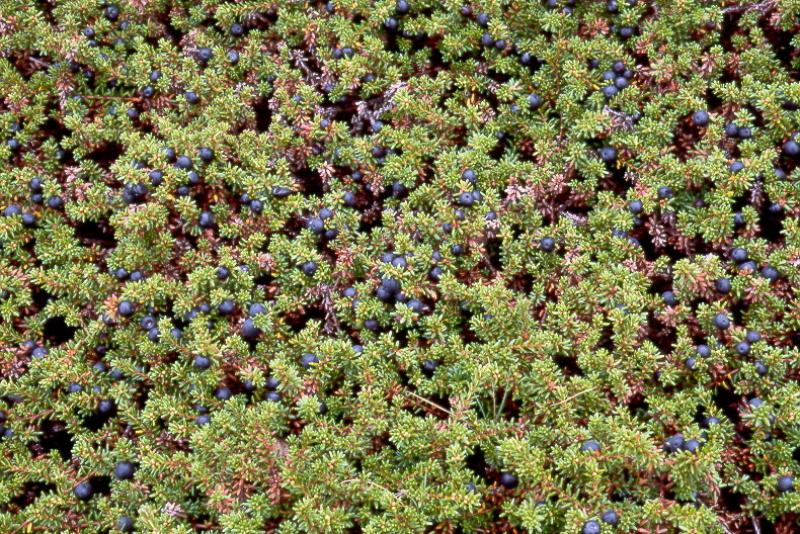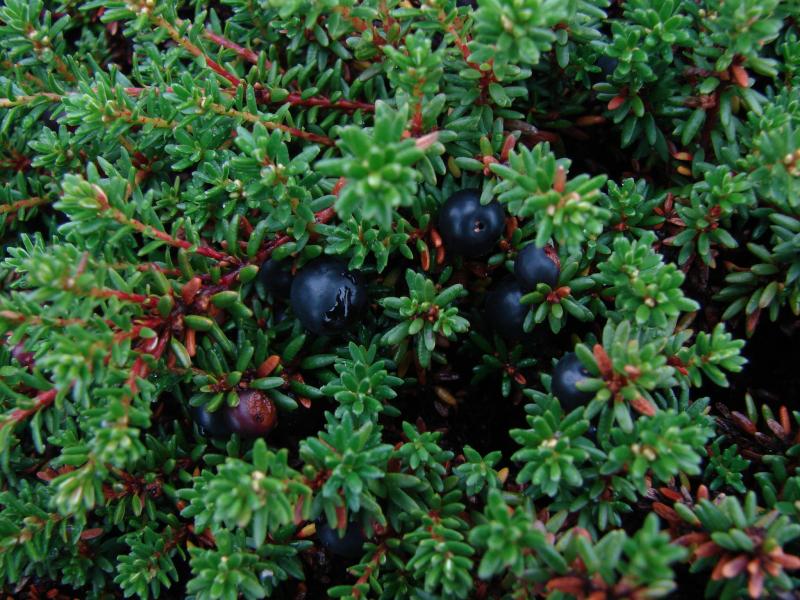Black Crowberry
Empetrum nigrum L.
- Class
- Dicotyledoneae (Dicots)
- Family
- Ericaceae (Heath Family)
- State Protection
- Threatened
Listed as Threatened by New York State: likely to become Endangered in the foreseeable future. For animals, taking, importation, transportation, or possession is prohibited, except under license or permit. For plants, removal or damage without the consent of the landowner is prohibited.
- Federal Protection
- Not Listed
- State Conservation Status Rank
- S2
Imperiled in New York - Very vulnerable to disappearing from New York due to rarity or other factors; typically 6 to 20 populations or locations in New York, very few individuals, very restricted range, few remaining acres (or miles of stream), and/or steep declines.
- Global Conservation Status Rank
- G5
Secure globally - Common in the world; widespread and abundant (but may be rare in some parts of its range).
Summary
Did you know?
The genus name Empetrum comes from the Greek en, which means upon, and petros, which means rock (Fernald 1970). This name alludes to the way this species grows on rocks. The common name black crowberry refers to the black color of the fruits and makes reference to the fact that, at least in the arctic where this plant also grows, birds relish the fruits (Waller and DiGregorio 1997). This plant's Inuit name, paurngait, means "which looks like soot", and refers to the black berries (S. G. Aiken et al 1989).
Conservation and Management
Habitat
Habitat
In New York, this species occurs on many of the highest summits of the Adirondacks, in alpine meadows sometimes adjacent to krummholz. It is also known at least historically from slightly lower sites on rock ledges and outcrops, and perhaps a bog, in cool microclimates in the high peaks region of the Adirondacks. There is also one disjunct extirpated population that was known from a maritime site on eastern Long Island (New York Natural Heritage Program 2007). Exposed, peaty and rocky areas (Haines and Vining 1998). On rocks (Gleason and Cronquist 1991). Arctic regions, peaty soils in more southern locations, alpine areas of northern New England and New York (Fernald 1970).
Associated Ecological Communities
- Maritime bluff*
(guide)
A sparsely vegetated community that occurs on vertical exposures of unconsolidated material, such as small stone, gravel, sand, and clay, that is exposed to maritime forces, such as water, ice, or wind.
- Maritime grassland*
(guide)
A grassland community that occurs on rolling outwash plains of the glaciated portion of the Atlantic coastal plain, near the ocean and within the influence of offshore winds and salt spray.
- Maritime heathland*
(guide)
A dwarf shrubland community that occurs on rolling outwash plains and moraine of the glaciated portion of the Atlantic coastal plain, near the ocean and within the influence of onshore winds and salt spray.
- Open alpine community
(guide)
An open community consisting of a mosaic of sedge/dwarf shrub meadows, dwarf heath shrublands, small boggy depressions, and exposed bedrock covered with lichens and mosses. The open alpine community occurs above timberline (about 4,900 ft or 1,620 m) on the higher mountain summits and exposed ledges of the Adirondacks. The flora includes arctic-alpine species that are restricted (in New York) to these areas, as well as boreal species that occur in forests and bogs at lower elevations. The soils are thin and organic, primarily composed of peat derived from peat mosses (Sphagnum spp.) or black muck. The soils are often saturated because they can be recharged by atmospheric moisture.
* probable association but not confirmed.
Associated Species
- Agrostis mertensii (northern bent)
- Betula glandulosa (alpine birch, resin birch)
- Carex bigelowii
- Carex scirpoidea ssp. scirpoidea (Canadian single-spike sedge)
- Diapensia lapponica var. lapponica
- Empetrum eamesii ssp. atropurpureum
- Geocaulon lividum (false toadflax)
- Hierochloe alpina ssp. orthantha
- Huperzia appressa (mountain firmoss)
- Minuartia groenlandica
- Prenanthes boottii
- Prenanthes nana
- Rhododendron groenlandicum (Labrador-tea)
- Rhododendron lapponicum var. lapponicum
- Salix uva-ursi (bearberry willow)
- Sibbaldiopsis tridentata
- Solidago leiocarpa (Cutler's alpine goldenrod)
- Solidago simplex var. monticola
- Trichophorum caespitosum
- Vaccinium boreale (northern lowbush blueberry)
- Vaccinium uliginosum (bog bilberry)
Range
Global Distribution
Empetrum nigrum ssp. hermaphroditum occurs in the northern parts of Europe and Asia as well as Greenland and eastern North America, south to northern Minnesota, Michigan, the coast of Maine, the alpine areas of northern New England and New York, and formerly one disjunct on Long Island (Fernald 1970, Anderberg 1994, New York Natural Heritage Program 2007). Depending on the circumscription of this taxon it is also considered to occur in the arctic regions of western North America south to the alpine areas of northern California to southern Alberta (Fernald 1970).
Identification Comments
General Description
Black crowberry is a very low trailing shrub that makes an attractive dense ground cover in the exposed alpine areas where it occurs. Its twigs, at least when young, have hairs with glands on the tips. The evergreen leaves are short and needle-like with tiny glandular teeth along the margins. The leaves are mostly without hairs and spread or reflex back from the braches where they arise. The small and inconspicuous flowers occur in the axils of the leaves. The fruits are about .25 to .35 inches in diameter, black, and sometimes have a thin white waxy coating (Fernald 1970, Gleason and Cronquist 1991).
Identifying Characteristics
This species is a trailing woody evergreen shrub. The twigs and branchlets especially when young are minutely stipitate-glandular and are not densely white-tomentose or white-villose. The leaves are evergreen, needle-like, and stiff. The flowers are mostly bisexual. The drupes are black and glaucous.
Best Life Stage for Proper Identification
This species can be easily identified throughout the year when snow is not covering it, although, fruits make identification easier.
Similar Species
The other species of Empetrum (E. eamesii ssp. atropurpureum) that occurs in New York and can be present with E. nigrum ssp. hermaphroditum is superficially very similar. It differs in having twigs and brachlets white-tomentose or white-villous and not stipitate glandular, and drupes purple-black. Its new leaves have white hairs along the entire margin.
Harrimanella hypnoides is another alpine plant that is believed to be extirpated in New York. It perhaps could be mistaken for Empetrum nigrum ssp. hermaphroditum when vegetative due to its evergreen needle like leaves. It can be distinguished by its smaller size, its rough margined leaves that arise along the entire stem, and its showy, white, bell-shaped flowers at the tips of stems, which mature into dry capsules.
Best Time to See
This plant starts to have fruits in July and these can last into the fall. Therefore, the best time to survey for this species is from July through late October although it can be distinguished vegetatively anytime during the growing season.
- Vegetative
- Flowering
- Fruiting
The time of year you would expect to find Black Crowberry vegetative, flowering, and fruiting in New York.
Black Crowberry Images
Taxonomy
Black Crowberry
Empetrum nigrum L.
- Kingdom Plantae
- Phylum Anthophyta
- Class Dicotyledoneae
(Dicots)
- Order Ericales
- Family Ericaceae (Heath Family)
- Order Ericales
- Class Dicotyledoneae
(Dicots)
- Phylum Anthophyta
Additional Common Names
- Curlew-berry
Synonyms
- Empetrum eamesii ssp. hermaphroditum (Lange ex Hagerup) D. Love
- Empetrum hermaphroditum Lange ex Hagerup
- Empetrum nigrum var. hermaphroditum (Hagerup) T.J. Sørensen
Comments on the Classification
A. A. Anderberg (1994c) and V. Mirré (2004) found good separation of the red-fruited Southern Hemisphere plants (Empetrum rubrum Vahl ex Willdenow), although Li J. H. et al. (2002) and M. Popp et al. (unpubl.) did not. Nevertheless, we are treating E. rubrum as distinct from all North American taxa. Popp et al. did find that red-fruited, diploid E. eamesii was well separated from other taxa in the region, whereas, in terms of molecular genetics, the Southern Hemisphere red-fruited diploid E. rubrum has its closest connections in the Northern Hemisphere not to E. eamesii but to black-fruited Northern Hemisphere plants treated here as E. nigrum in the broad sense. The solution is to recognize the diploid E. eamesii, the diploid and tetraploid E. nigrum, and E. atropurpureum as a possible allotetraploid from diploid E. eamesii and a diploid E. nigrum. This leaves a great deal of variation within E. nigrum in the broad sense unaccounted for. Various hybrid combinations were alleged by D. Löve (1960); these require confirmation.
Additional Resources
Best Identification Reference
Gleason, Henry A. and A. Cronquist. 1991. Manual of Vascular Plants of Northeastern United States and Adjacent Canada. The New York Botanical Garden, Bronx, New York. 910 pp.
Other References
Aiken, S.G., M.J. Dallwitz, L.L. Consaul, C.L. McJannet, L.J. Gillespie, R.L. Boles, G.W. Argus, J.M. Gillett, P.J. Scott, R. Elven, M.C. LeBlanc, A.K. Brysting and H. Solstad. 2003. Flora of the Canadian Arctic Archipelago: Descriptions, Illustrations, Identification, and Information Retrieval. Version: 29th April 2003. http://www.mun.ca/biology/delta/arctic
Anderberg, A.A. 1994. Phylogeny of the Empetraceae, with Special Emphasis on Character Evolution in the Genus Empetrum. Systematic Botany 19: 35-46.
Fernald, M.L. 1950. Gray's manual of botany. 8th edition. D. Van Nostrand, New York. 1632 pp.
Flora of North America Editorial Committee. 2010. Flora of North America North of Mexico. Vol. 08. Magnoliophyta: Paeoniaceae to Ericaceae. Oxford Univ. Press, New York. xxiv + 585 pp.
Haines, A. and T.F. Vining. 1998. Flora of Maine, A Manual for Identification of Native and Naturalized Vascular Plants of Maine. V.F.Thomas Co., Bar Harbor, Maine.
Holmgren, Noel. 1998. The Illustrated Companion to Gleason and Cronquist's Manual. Illustrations of the Vascular Plants of Northeastern United States and Adjacent Canada. The New York Botanical Garden, Bronx, New York.
Judd, W.S.and K.A. Kron. 1993. Circumscription of Ericaceae (Ericales) as Determined by Preliminary Cladistic Analyses Based on Morphological, Anatomical, and Embryological Features. Brittonia 45: 99-114.
Li, J., J. Alexander III, T. Ward, P.D. Tredici, and R. Nicholson. 2002. Phylogenetic relationships of Empetraceae inferred from sequences of chloroplast gene matK and nuclear ribosomal DNA its region. Molecular Phylogenetics and Evolution 25: 306-315.
New York Natural Heritage Program. 2010. Biotics database. New York Natural Heritage Program. New York State Department of Environmental Conservation. Albany, NY.
New York Natural Heritage Program. 2024. New York Natural Heritage Program Databases. Albany, NY.
Reschke, Carol. 1990. Ecological communities of New York State. New York Natural Heritage Program, New York State Department of Environmental Conservation. Latham, NY. 96 pp. plus xi.
Waller, J. and M.J. DiGregorio. 1997. New England's Mountain Flowers. A High Country Heritage. Mountain Press Publishing Company, Missoula, Montana.
Weldy, T. and D. Werier. 2010. New York flora atlas. [S.M. Landry, K.N. Campbell, and L.D. Mabe (original application development), Florida Center for Community Design and Research http://www.fccdr.usf.edu/. University of South Florida http://www.usf.edu/]. New York Flora Association http://newyork.plantatlas.usf.edu/, Albany, New York
Links
About This Guide
Information for this guide was last updated on: October 25, 2019
Please cite this page as:
New York Natural Heritage Program. 2024.
Online Conservation Guide for
Empetrum nigrum.
Available from: https://guides.nynhp.org/black-crowberry/.
Accessed April 27, 2024.

